INTRODUCTION
Pearl millet (Pennisetum glaucum (L.) R. Br.), is the fourth most important food grain crop after rice, wheat and sorghum in India. The contribution of pearl millet to the total Fe and Zn intake from all food sources has been reported to very widely vary across rural India. For instance, it was observed to be contributing 19-63 per cent of the total Fe intake and 16-56 per cent of the total Zn intake in parts of Rajasthan, Maharashtra and Gujarat states (Parthasarathy et al., 2006). Constant efforts have been made to improve grain yield and its contributing characters through hybridization in pearl millet. Proper selection of parents is very crucial in planned hybridization programme. Combining ability provides useful information regarding the selection of suitable parents for effective hybridization programme and at the same time elucidates the nature and magnitude of different types of gene action. Since, the nature of gene action varies with genetic architecture of population involved in hybridization, it is necessary to evaluate the parents for their combining ability. This information enables the breeder to evaluate and classify selected parental material for their utility in development of high yielding F1 hybrids in pearl millet, where hybrids are being cultivated on commercial scale. The current experiment was laid out comprising of fifty hybrids and fifteen parents of pearl millet to determine the combining ability for grain yield, Morpho-physiological and Nutritional traits.
MATERIAL AND METHODS
This trial was conducted with 50 hybrids, 5 lines and 10 testers in over pooled seasons at ARS, Podalakur in RBD replicated thrice. Every genotype was sown in one row of four meters length with 45 × 15 cm spacing. All management practices were followed as and when required to establish a good crop. Observations were recorded on 15 economically important characters viz., Days to 50% flowering, Days to maturity, productive tillers plant-1, Plant height (cm), Panicle length (cm), Panicle girth (cm), 1000 grain weight (g), Grain yield (t ha-1), Green fodder yield (t ha-1), Dry fodder yield (t ha-1), SPAD chlorophyll meter readings (60 DAS), Relative water content (%), Harvest index (%), Grain Fe content (ppm), Grain Zn content (ppm). Data from all the characters studied were exposed to analysis of variance technique on the basis of model proposed by Panse and Sukhatme (1967). The analysis of variance (ANOVA) method, as described by Singh and Chowdary (1985), was used. The combining ability analysis was carried out according to the method suggested by Kempthorne (1957).
RESULTS AND DISCUSSION
Combining ability analysis is of vital importance in crops like pearl millet as it helps in identification of potential parents with good gca effects and hybrids with good sca effects (Sprague and Tatum, 1942). As a general rule, general combining ability (GCA) is the result of additive gene effects and additive × additive interaction which are fixable, while the specific combining ability (SCA) is the result of non- additive gene effects that includes dominance, epistasis and other interactions which are non-fixable (Jinks, 1954). Parents with desirable gca effects for the targeted characters can be used to accumulate favourable alleles by recombination and selection in evolving productive hybrids. Knowledge on the nature and magnitude of gene actions involved in the inheritance of various quantitative characters is important in developing an effective and sound breeding programme. The present investigation was carried out with an objective of identifying potential parents and specific cross combinations for yield and yield components under four seasons and pooled over seasons through combining ability.
Analysis of Variance for Combining Ability
Combining ability analysis was carried out utilising the mean data recorded on replication wise for all the 15 characters in 50 hybrids using L × T mating design separately for all the four seasons viz., kharif 2020 (E1), late kharif 2020 (E2), rabi 2020-21 (E3) and summer (E4) and pooled data over seasons. ANOVA for combining ability analysis for all the characters studied is presented in Table 1. Combining ability analysis indicated that mean sum of squares due to GCA, SCA and seasons were significant for all the characters studied in all four seasons.
Pooled analysis of variance for combining ability over four seasons is presented in Table 1. The variance components due to GCA, SCA and seasons showed the highly significant differences for all the characters. Mean sum of squares due to GCA × Seasons and the interaction of SCA × Seasons also exhibited significant differences for all characters. Significant mean sum squares due to
seasons and GCA × Seasons and SCA × Seasons for yield and yield components indicate that both additive and non-additive genetic variances are greatly influenced by environments (Seasons).
The detailed results of combining ability effects and variances for all characters under consideration are presented here under season wise and pooled over seasons.
General Combining Ability (gca) Effects
A perusal of estimates of gca effects in pooled data analysis revealed that none of the parents tested were found to be the good general combiners for all the characters. However, a few parents showed desirable gca effects for most of the characters under study. ICMR 100549 is best suitable cultivar for number of productive tillers plant-1, ICMR 08666 for plant height(cm) and green fodder yield (t ha-1), ICMR 13999 for panicle length (cm), grain yield (t ha-1) and Relative water content (%), ICMR 100549 for panicle girth (cm) and dry fodder yield (t ha-1), ICMR 13999 for 1000 grain weight (g), days to 50% flowering and days to maturity, ICMB 98222 for SPAD chlorophyll meter readings (60 DAS), ICMR 100087 for harvest index (%) ICMR 12555 for Grain Fe content (ppm) and Grain Zn content (ppm).
Among the testers ICMR 100556 was identified as the best general combiner as it registered significant gca effects in desired direction for number of productive tillers plant-1, plant height (cm), panicle girth (cm), 1000 grain weight (g), grain yield (t ha-1), green fodder yield (t ha-1), days to 50% flowering, days to maturity, SPAD chlorophyll meter reading (SCMR), relative water content (%), harvest index (%) and nutritional parameters grain Fe content (ppm) and grain Zn content (ppm). The tester parent ICMR 13999 registered significant gca effects in desired direction for number of productive tillers plant-1, plant height (cm), panicle length (cm), panicle girth (cm), 1000 grain weight (g), grain yield (t ha-1), green fodder yield (t ha-1), dry fodder yield (t ha-1), days to 50% flowering, days to maturity, SPAD chlorophyll meter reading (SCMR) and relative water content (%). Crosses involving these parents might produce heterotic hybrids with high mean performance for the respective traits (Table 2).
Among the lines, ICMB 98222 exhibited desirable significant gca effects for nine characters viz., number of productive tillers plant-1, plant height (cm), panicle girth
Table 1. Pooled analysis of variance for combining ability for grain yield, morpho-physiological and nutritional traits over four seasons
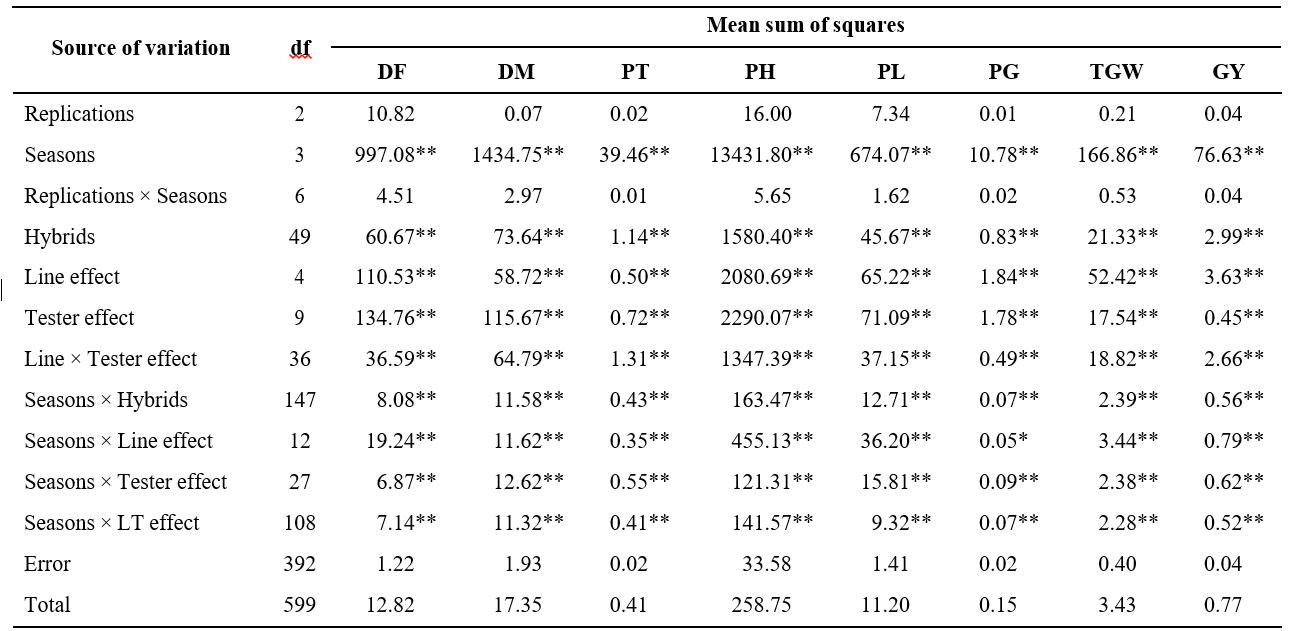
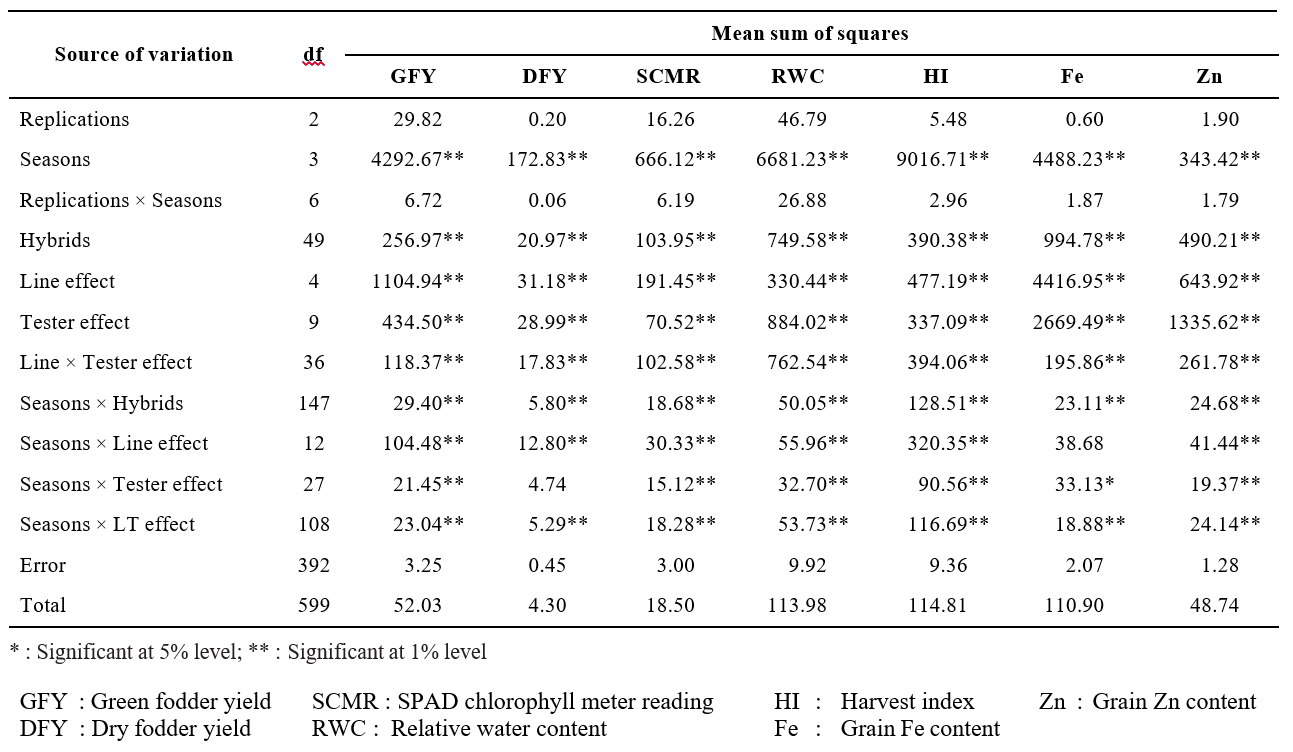
(cm), 1000 grain weight (g), grain yield (t ha-1), SPAD chlorophyll meter reading (SCMR), harvest index (%) and nutritional parameters grain Fe content (ppm) and grain Zn content (ppm). However, the parent ICMR 1809 registered as poor general combing ability effects in desirable direction for all the characters except harvest index (%) (Table 2).
Based on the above discussion, it could be concluded that among the tested 15 parents. The parent viz., ICMR 100556 was found to be good general combiner for grain yield and most of the yield characters, earliness and nutritional parameters grain Fe content (ppm) and grain Zn content (ppm). The parent ICMR 13999 was found be the good general combiner for grain yield and most of the yield characters and earliness. As gca effects are attributed to additive gene effects, the parents ICMR 100556 and ICMR 13999 might be considered as potential parents for pearl millet improvement programme aimed at yield, earliness and nutritional parameters grain Fe content (ppm) and grain Zn content (ppm).
Specific Combining Ability (sca) Effects
Based on the gca effects of the parents involved in specific cross combinations, the hybrids may be grouped into three categories viz., good × good, good
× poor or poor × good and poor × poor combinations. Most of the hybrids with high and significant sca effects did not involve both the parents with good gca effects. Contrary to this, hybrids involving parents possessing good gca effects did not result in significant sca effects in desired direction. The cross combinations with high and significant sca effects for more than one yield contributing characters would yield better hybrids. These types of hybrids could be better utilised in population improvement programme via recurrent selection so as to isolate superior parents.
Perusal of sca effects recorded in the present investigation for 50 hybrids in pooled analysis suggested that none of the cross combinations registered significant sca effects in desired direction for all the 15 characters studied. Hence, to decide the sca status of a cross, it is necessary to consider the sca effects for different characters. ICMB 98222 × ICMR 100584 is best suitable cross for Number of productive tillers plant-1, ICMB 99222 × ICMR 08444 for plant height (cm), ICMB 08666 × ICMR 12555 for panicle length (cm), panicle girth (cm) and grain yield (t ha-1), ICMB 04999 × ICMR 100089 for 1000 grain weight (g), ICMB 04999 × ICMR 100584 for green fodder yield (t ha-1), ICMB 99222 × ICMR 100556 for dry fodder yield-1 (t ha-1), ICMB 04999 × ICMR 100549 for days to 50% flowering, ICMB 04999 × ICMR 100549 for days to maturity, ICMB 06111 × ICMR 100556 for SPAD chlorophyll meter readings (60 DAS), ICMB 04999 × ICMR 12555 for Relative water content, ICMB 08666 × ICMR 13999 for Harvest index (%), ICMB 08666 × ICMR 12555 for Grain Fe content (ppm), ICMB 06111 × ICMR 08444 for Grain Zn content (ppm). The top five hybrids in pooled over seasons, viz., ICMB 08666 × ICMR 12555, ICMB 99222 × ICMR 100587, ICMB 06111 × ICMR 08444, ICMB 04999 × ICMR 100549 and ICMB 98222 × ICMR 100584 recorded significant positive sca effects for grain yield. Among them, the hybrid ICMB 08666 × ICMR 12555 (good × poor) registered desirable and significant sca effects in all the four seasons kharif, late kharif, rabi and summer and pooled over seasons for number of productive tillers plant-1, plant height (cm), panicle length (cm), panicle girth (cm), 1000 grain weight (g), grain yield (t ha-1), days to 50% flowering, days to maturity, SPAD chlorophyll meter reading (SCMR), harvest index and nutritional parameters grain Fe content (ppm) and grain Zn content (ppm); The hybrid ICMB 06111 × ICMR 08444 (poor × poor) recorded significant positive sca effects in three seasons kharif, late kharif and summer for Number of productive tillers plant-1, panicle length (cm), panicle girth (cm), 1000 grain weight (g), grain yield (t ha-1), green fodder yield (t ha- 1), dry fodder yield (t ha-1), days to 50% flowering, days to maturity, relative water content (%) and nutritional parameters grain Fe content (ppm) and grain Zn content (ppm) (Table 3).
Hence, these hybrids ICMB 08666 × ICMR 12555 (good × poor) and ICMB 06111 × ICMR 08444 (poor × poor) registered desirable and significant sca effects for most of yield components, earliness, SPAD chlorophyll meter reading (SCMR) and nutritional parameters grain Fe content (ppm) and grain Zn content (ppm). Hence these hybrids may be utilized in breeding high yielding hybrids coupled with earliness, drought and nutritional parameters grain Fe content (ppm) and grain Zn content (ppm). The importance of non-additive gene action as documented in this present study is in agreement with the findings of Mungra et al. (2015), Badurkar et al. (2018), Barathi et al. (2020), Anuradha et al., (2020), Anusha et al., (2021).
Table 2. Estimates of general combining ability effects (gca) of lines and testers for grain yield, morpho-physiological and nutritional traits in pooled over seasons
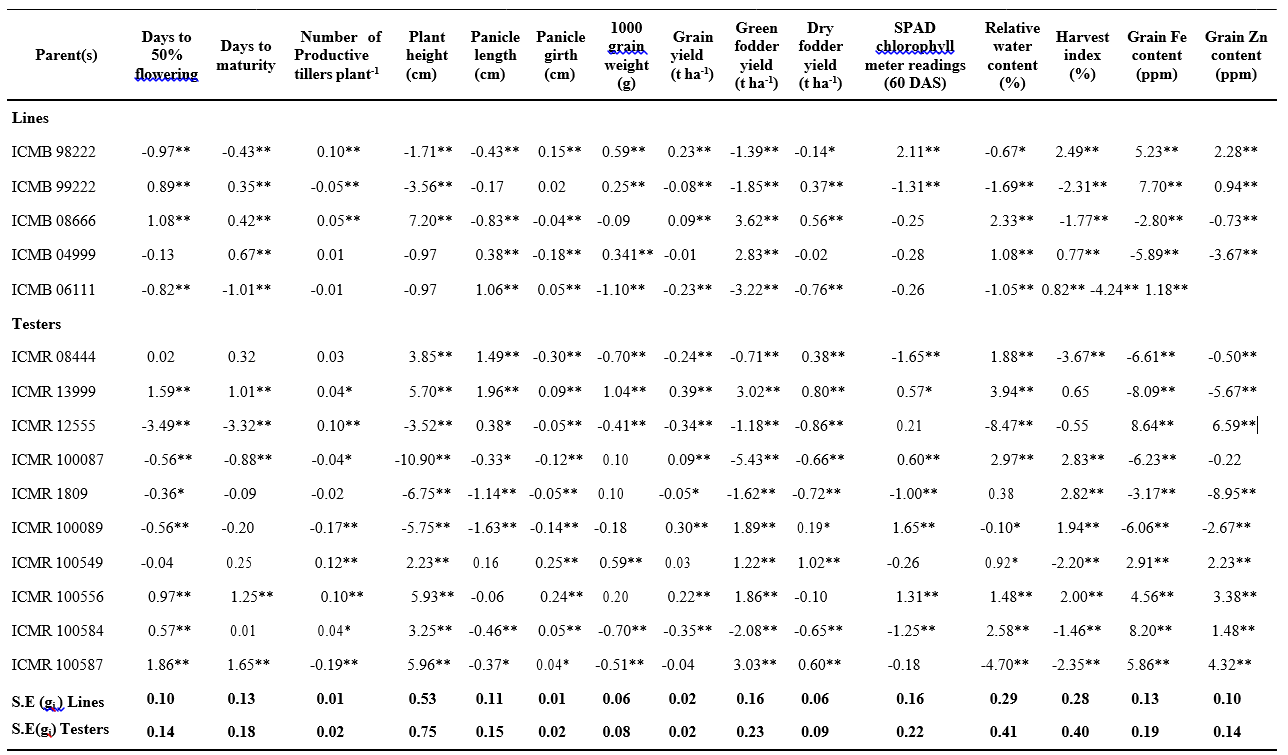
Table 3. Estimates of specific combining ability effects of 50 hybrids for grain yield, morpho-physiological and nutritional traits in pooled over seasons
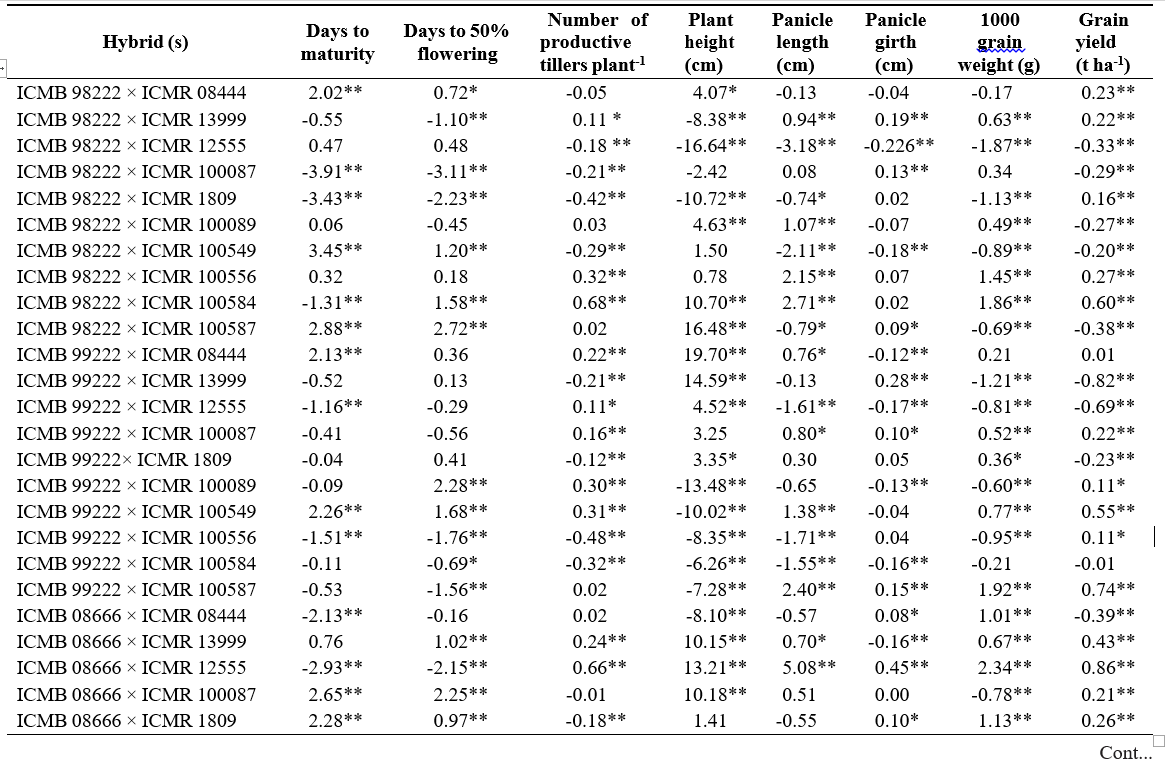
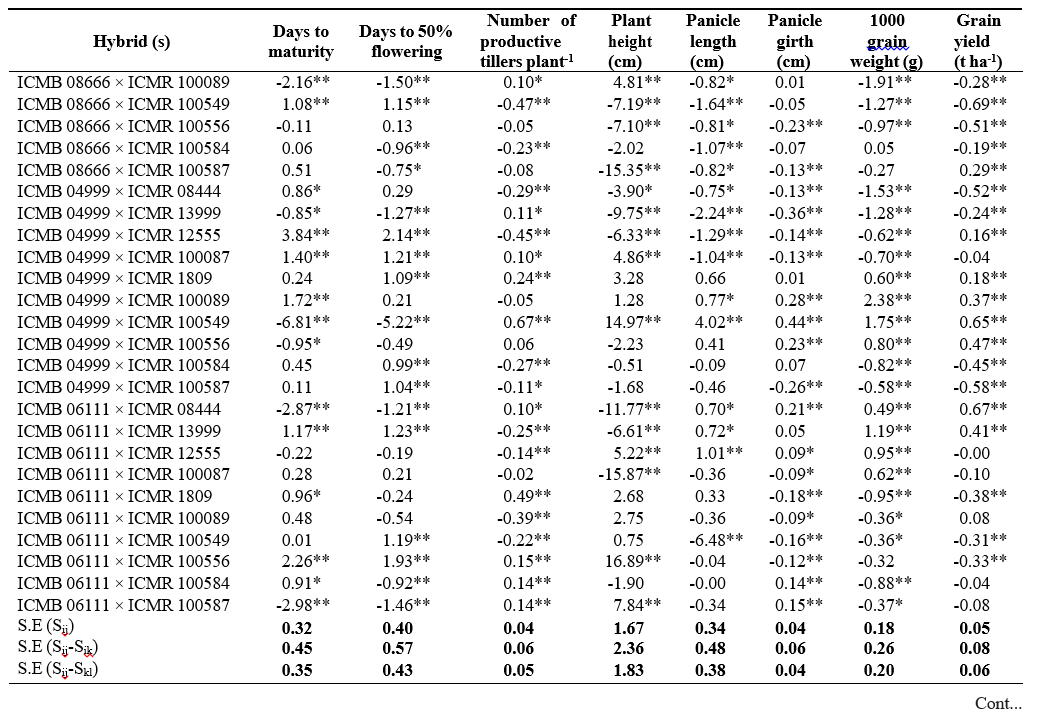
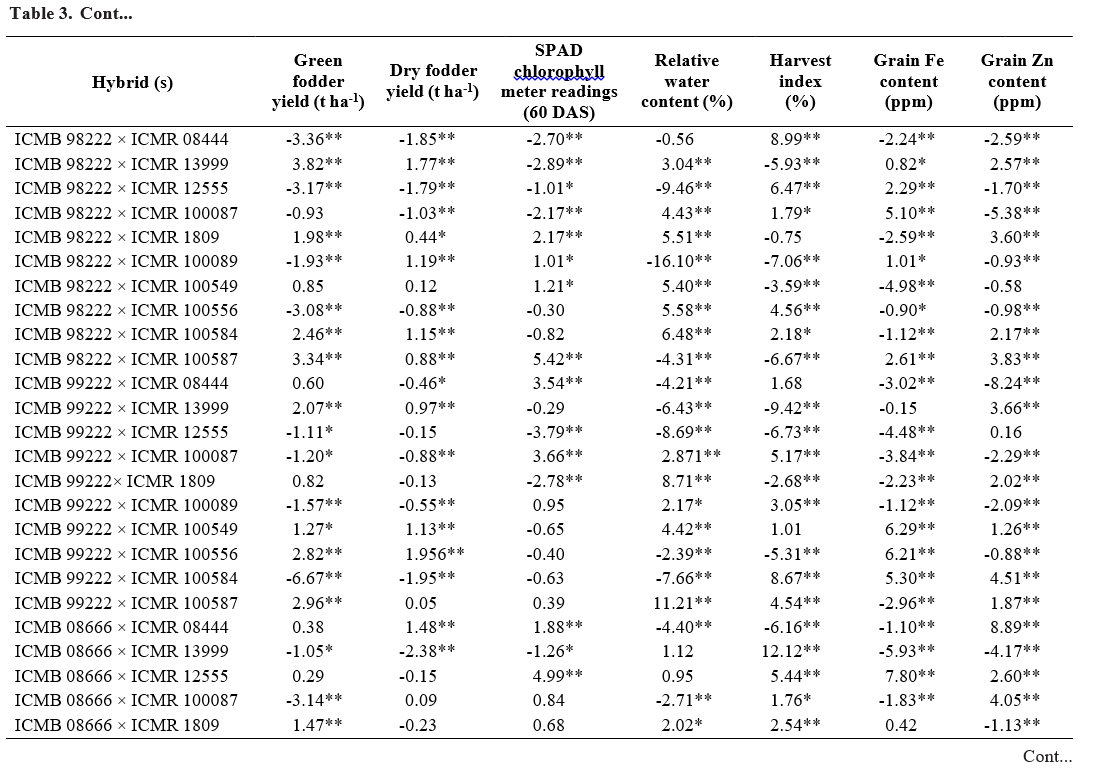
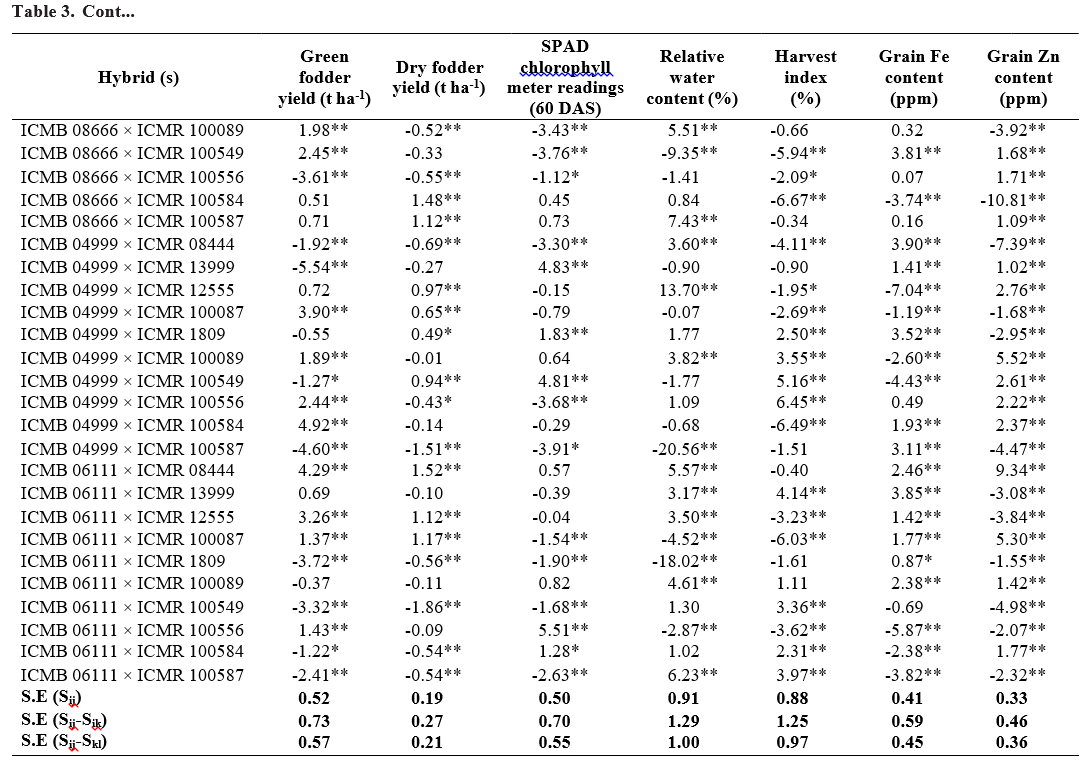
LITERATURE CITED
Anuradha, N., Priya, P.K., Patro, T.S.S.K., Rani, Y.S and Triveni, U. 2020. Character association, variability and heritability studies for grain yield and its yield attributes in pearl millet (Pennisetum glaucam (L.) R. Br). International Journal of Current Microbiology and Applied Sciences. Special Issue 11: 1459-1464.
Anusha, G., Rao, D.S., Jaldhani, V., Beulah, P., Neeraja, C.N., Gireesh, C., Anantha, M.S., Suneetha, K., Santhosha, R., Prasad, A.S.H., Sundaram, R.M., Madhav, M.S., Fiyaz, A., Brajendra, P., Tuti, M.D., Bhave, M.H.V., Krishna, K.V.R., Ali, J., Subrahmanyam, D and Senguttuvel, P. 2021. Grain Fe and Zn content, heterosis, combining ability and its association with grain yield in irrigated and aerobic rice. Scientific reports. 11(1): 1-12.
Badurkar, S.B., Pole, S.P., Toprope, V.N and Ingle,
N.P. 2018. Combining ability for grain yield and its related traits in pearl millet (Pennisetum glaucum (L.) R. Br.). International Journal of Current Microbiology and Applied Sciences. Special Issue 6: 956-961.
Barathi, M.B., Lakshmi, B.V., Reddy, P.S and Umar, Sk.N. 2020. Heterosis and combining ability studies in indigenous collection of Pearl Millet germplasm [Pennisetum glaucum (L.) R. Br.]. International Journal of Current Microbiology and Applied Sciences. 9(10): 2648-2660.
Jinks, J.L. 1954. The analysis of continuous variation in a diallele crosses of Nicotiana rustica varieties. Genetics. 39: 767-788.
Kempthorne, O. 1957. An introduction to genetic statistics. John Wiley and Sons, Inc., New York. 222-240.
Krishnan, M.R.R., Patel, M.S., Gami, R.A., Bhadauria,
H.S and Patel, Y.N. 2017. Genetic analysis in pearl Millet [Pennisetum glaucum (L) R. Br.]. International Journal of Current Microbiology and Applied Sciences. 6(11): 900-907.
Mungra, K.S., Dobariya, K.L., Sapovadiya, M.H and Vavdiya, P.A. 2015. Combining ability and gene action for grain yield and its component traits in pearl millet (Pennisetum glaucum (L.) R. Br.). Electronic Journal of Plant Breeding. 6(1): 66-73.
Panse, V.G and Sukhatme, P.V. 1967. Statistical Methods for Agricultural Workers. ICAR Publication, New Delhi. 145-152.
Parthasarathy, R.P., Birthal, P.S., Reddy, B.V.S., Rai,
K.N and Ramesh, S. 2006. Diagnostics of sorghum and pearl millet grains-based nutrition in India. Int Sorghum Millets News. l47: 93-96.
Singh, R.K and Chowdary, B.D. 1985. Biometrical methods in Quantitative Genetic Analysis. 38–54. Kalyani Publisher, New Delhi, India.
Sprague, G.F and Tatum, L.A. 1942. General vs specific combining ability in single crosses of corn. Journal of American Society of Agronomy. 34: 923-932.